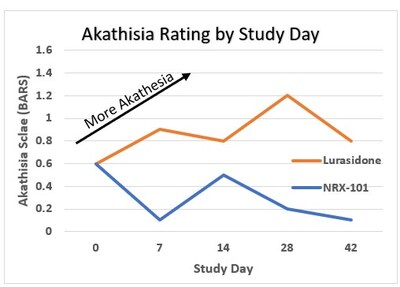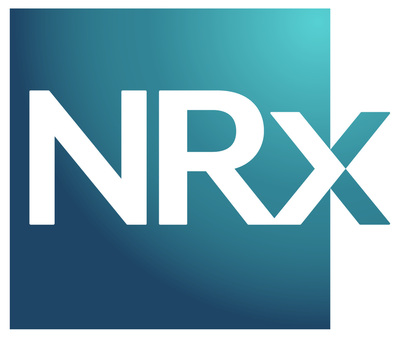Press Releases
- Both drugs demonstrated > 50% response for treating depression. NRX-101 demonstrated a mean 76% reduction in symptoms of akathisia compared to lurasidone that was sustained over 42 days (Effect Size .37; P=0.025), using prespecified analytic methodology memorialized in FDA Special Protocol Agreement. Levels of akathisia with NRX-101 were essentially zero at day 42
- This safety advantage was previously reported in the Company's published STABIL-B trial
- Akathisia is identified as a life-threatening side effect of nearly all antidepressants, reported in 10-15% of treated patients and is closely linked to suicide in FDA black box warning
- Akathisia was seen in 2% of participants treated with NRX-101 vs. 11% treated with lurasidone
- Company plans to seek accelerated approval of NRX-101 for use in patients with bipolar depression at risk of akathisia while continuing to broaden the indication to all patients with bipolar depression and perhaps schizophrenia
- Study will be presented at the American Society of Clinical Psychopharmacology (ASCP) meeting May 28-31, 2024 (Miami) together with study investigators, accompanied by a broadcast scientific presentation on akathisia and antidepressant safety, and investor Q&A
RADNOR, Pa., May 6, 2024 /PRNewswire/ -- NRx Pharmaceuticals, Inc. (Nasdaq: NRXP) ("NRx Pharmaceuticals", the "Company"), a clinical stage pharmaceutical company, today announced a statistically significant safety advantage of NRX-101 compared to the standard of care comparator in its recently completed clinical trial in patients with suicidal bipolar depression. Therefore, the Company believes that demonstration of reduced akathisia in the setting of comparable antidepressant efficacy constitutes a basis for Accelerated FDA Approval of NRX-101. The full clinical trial results will be presented at the upcoming meeting to the American Society of Clinical Psychopharmacology held May 28-31, 2024 in Miami. NRx will gather Key Opinion Leaders to educate the public on the importance and potentially life-saving implication of this finding.
Last week, the Company released preliminary top-line data as required by SEC disclosure rules. The Company believes that today's findings based on mixed model regression analysis as specified in the Company's Special Protocol Agreement with the FDA, when combined with the prior STABIL-B trial1, demonstrate a basis for seeking accelerated drug approval of NRX-101 based on improved safety related to akathisia and suicidality in the setting of comparable antidepressant efficacy.
Trial participants had identical mean scores on the Barnes Akathisia Rating Scale (BARS) at baseline with subsequent decrease in the NRX-101 treated group versus an increase in the lurasidone-treated group, yielding a 76% relative mean difference between the groups. The difference was apparent at the first post-randomization visit and continued throughout the trial. (Fig 1) Over the 42 days of observation, an effect size of .37 was identified with a statistically significant P value of 0.025 on the Mixed Model for Repeated Measures (MMRM) methodology agreed to with FDA in the 2018 Special Protocol Agreement. Akathisia as ascertained by a 1 point increase in the BARS was seen in 11% of participants randomized to lurasidone (comparable to previous reports in the literature) and seen in only 2% of those treated with NRX-101, an akathisia level that was previously reported for the placebo arm of the lurasidone registration trial.
Akathisia was a prespecified key safety endpoint of the Company's clinical trial. Hence this finding is not a "post-hoc" observation. As previously noted, this clinical trial of 91 participants with suicidal bipolar depression who were not pre-treated with ketamine demonstrated that NRX-101 and lurasidone were comparable in their antidepressant effect. A 33% but statistically non-significant sustained decrease in suicidality was also seen favoring NRX-101. As noted above, improved antidepressant efficacy is not required to seek drug accelerated drug approval based on a statistically-significant safety benefit.
Based on this safety finding, NRx plans to seek Accelerated Approval of NRX-101 for treatment of bipolar depression in patients at risk for akathisia who are at highest risk of suicide, while continuing to develop evidence to support broader indications both in treatment of depression and schizophrenia. Should these data be confirmed in additional large scale trials, the Company believes that physicians and patients will universally prefer antidepressant and antipsychotic drugs with a reduced akathisia risk. The NRx patent portfolio supports the development of a broad range of combined NMDA/serotonergic drugs for treatment of depression and psychosis.
There is a recent regulatory precedent for the approval of psychiatry drugs that demonstrate comparable efficacy with improved safety. A combination of olanzapine and samidorphan (LYBALVI®) was approved based on comparable effect on schizophrenia symptoms with evidence of less weight gain favoring LYBALVI. Thus, public assertions by journalists and short-sellers that NRx has no path to market based on the finding of comparable efficacy in this trial are utterly baseless and may be designed to mislead investors.
"More than 7 million Americans suffer from bipolar depression with a potential market opportunity in excess of $20 billion. No prior drug to treat bipolar depression has demonstrated superiority on side effects most closely linked to suicide. Patients with bipolar depression have a 50% lifetime risk of a suicidal attempt and a 20% lifetime risk of dying from suicide. On this basis of these superiority findings, previously seen in the STABIL-B trial, we plan to seek Accelerated Approval from FDA for treatment of patients with bipolar depression who are at risk for akathisia, as we and our partners continue to broaden the indication to the treatment of all patients with bipolar depression." said Dr. Jonathan Javitt, NRx's Chairman and Chief Scientist. "Patients and key opinion leaders alike have told us clearly that an antidepressant with comparable antidepressant effect and reduced risk of akathisia and other risk factors for suicidality would be unambiguously preferred in the marketplace."
Background on Akathisia
Akathisia is a known extrapyramidal side effect of all serotonin-targeted antidepressants and antipsychotic drugs. It can be demonstrated in laboratory models, using rodent behavioral data.2 Prof. Daniel Javitt, the inventor of NRX-101 first discovered the ability of NMDA antagonist drugs to reduce akathisia in 2009, which forms the basis of the Company's composition of matter patent portfolio. In his 2012 patent application Javitt stated 3
A major limitation in use of antipsychotic and antidepressant medications is the liability to produce behavioral side effects, especially anxiety, agitation, and akathisia, all of which are associated with generating or exacerbating suicidality in psychotic or depressed patients. These behavioral side effects can be differentiated from symptoms of the illness by consideration of both time course and specific patterns of symptoms.
The side effect is clearly recognized in an FDA-mandated black box warning applied to lurasidone and all medications in its class of drugs, with a specific warning about suicidality as follows:
"The following symptoms, anxiety, agitation, panic attacks, insomnia, irritability, hostility, aggressiveness, impulsivity, akathisia (psychomotor restlessness), hypomania, and mania have been reported in adult and pediatric patients being treated with antidepressants for major depressive disorder as well as for other indications, both psychiatric and non-psychiatric. Although a causal link between the emergence of such symptoms and either the worsening of depression and/or the emergence of suicidal impulses has not been established, there is concern that such symptoms may represent precursors to emerging suicidality"4.
In most clinical trials, safety endpoints are not a basis for drug approval, although adverse safety findings may prevent drug approval. Typically, new drugs are compared to placebo in order to prove a difference in efficacy. In this case, the trial was conducted against the standard of care drug, not against placebo and, therefore, safety differences are highly important. Akathisia is a labeled negative side-effect of lurasidone and all similar drugs, and is closely linked to suicidal behavior.56 It is a side effect about which patients must be warned[7] and has figured prominently in class action lawsuits brought against manufacturers of serotonin-targeted antidepressants and antipsychotics. Currently, there is no FDA-approved treatment for akathisia and it is considered a medical emergency by many treating psychiatrists. Akathisia causes extreme anxiety to patients, inability to control motor movement, and impulsive acts, all to often leading to suicide and may be the key driver of the observed increase in suicidal ideation and behavior associated with all serotonin-targeted antidepressants and antipsychotic drugs.
"These studies support our original observation that D-cycloserine reverses the akathisia-like behaviors induced by lurasidone in rodent models. It is exciting to see those findings demonstrated in a second trial with unequivocal statistical significance," said Prof. Daniel Javitt, co-founder of NRx Pharmaceuticals. "Hopefully, this opens a path to bringing a lifesaving drug to millions of patients with suicidal depression whose only approved long-term treatment is electroconvulsive therapy."
About NRx Pharmaceuticals
NRx Pharmaceuticals is a clinical-stage biopharmaceutical company developing therapeutics based on its NMDA platform for the treatment of central nervous system disorders, specifically suicidal bipolar depression, chronic pain and PTSD. The Company is developing NRX-101, an FDA-designated investigational Breakthrough Therapy for suicidal treatment-resistant bipolar depression and chronic pain. NRx has partnered with Alvogen and Lotus around the development and marketing of NRX-101 for the treatment of suicidal bipolar depression. NRX-101 additionally has potential to act as a non-opioid treatment for chronic pain, as well as a treatment for complicated UTI.
NRx has recently announced plans to submit a New Drug Application for HTX-100 (IV ketamine), through Hope Therapeutics, in the treatment of suicidal depression, based on results of well-controlled clinical trials conducted under the auspices of the US National Institutes of Health and newly obtained data from French health authorities, licensed under a data sharing agreement. NRx was awarded Fast Track Designation for development of ketamine (NRX-100) by the US FDA as part of a protocol to treat patients with acute suicidality.
About HOPE Therapeutics, Inc.
HOPE Therapeutics, Inc. (www.hopetherapeutics.com) is a Specialty Pharmaceutical Company, wholly-owned by NRX Pharmaceuticals focused on development and marketing of an FDA-approved form of intravenous ketamine for the treatment of acute suicidality and depression together with a digital therapeutic-enabled platform designed to augment and preserve the clinical benefit of NMDA-targeted drug therapy.
Notice Regarding Forward-Looking Statements
The information contained herein includes forward-looking statements within the meaning of Section 21E of the Securities Exchange Act of 1934, as amended, and Section 27A of the Securities Act of 1933, as amended. These statements include, among others, statements regarding the proposed public offering and the timing and the use of the proceeds from the offering. Forward-looking statements generally include statements that are predictive in nature and depend upon or refer to future events or conditions, and include words such as "may," "will," "should," "would," "expect," "plan," "believe," "intend," "look forward," and other similar expressions among others. These statements relate to future events or to the Company's future financial performance, and involve known and unknown risks, uncertainties and other factors that may cause the Company's actual results to be materially different from any future results, levels of activity, performance or achievements expressed or implied by these forward-looking statements. You should not place undue reliance on forward-looking statements since they involve known and unknown risks, uncertainties and other factors which are, in some cases, beyond the Company's control and which could, and likely will, materially affect actual results, levels of activity, performance or achievements. Any forward-looking statement reflects the Company's current views with respect to future events and is subject to these and other risks, uncertainties and assumptions relating to the Company's operations, results of operations, growth strategy and liquidity. More detailed information about the Company and the risk factors that may affect the realization of forward-looking statements is set forth in the Company's most recent Annual Report on Form 10-K and other filings with the Securities and Exchange Commission. Investors and security holders are urged to read these documents free of charge on the SEC's website at http://www.sec.gov. Except as may be required by applicable law, The Company assumes no obligation to publicly update or revise these forward-looking statements for any reason, or to update the reasons actual results could differ materially from those anticipated in these forward-looking statements, whether as a result of new information, future events or otherwise.
|
1 Nierenberg A, Lavin P, Javitt DC, et. al. NRX-101 vs lurasidone for the maintenance of initial stabilization after ketamine in patients with severe bipolar depression with acute suicidal ideation and behavior; a randomized prospective phase 2 trial. Int J Bipolar Dis 2023;11:28-38, doi.org/10.1186/s40345-023-00308-5 |
|
2 Walf, A. A., & Frye, C. A. (2007). The use of the elevated plus maze as an assay of anxiety-related behavior in rodents. Nature Protocols, 2(2), 322-328. https://doi.org/10.1038/nprot.2007.44 |
|
3 Javitt DC. Composition and method for treatment of depression and psychosis in humans. US Patent 10583138B2. Granted March 10, 2020. |
|
4 Trivedi et al., J Clin Psychiatry, 72:765-774, 2011 |
|
5 Chow LC, Kahouh NK, Bostwick JR, et. al., Akathisia and newer second-generation antipsychotic drugs: A review of current evidence. Pharmacotherapy 202;40(6):565-574 doi: 10.1002/phar.2404 |
|
6 Uwai Y, Nabekura T. Risk factors for suicidal behavior/ideation and hostility/aggression in patients with bipolar disorders: An analysis using the Japanese adverse drug event report database. J Psychiatric Res 2022;153:99-103. https://doi.org/10.1016/j.jpsychires.2022.07.005 |
|
7 https://www.webmd.com/schizophrenia/side-effects-of-lurasidon |
SOURCE NRx Pharmaceuticals, Inc.
Click here to view our corporate presentation or on the image below
 |



